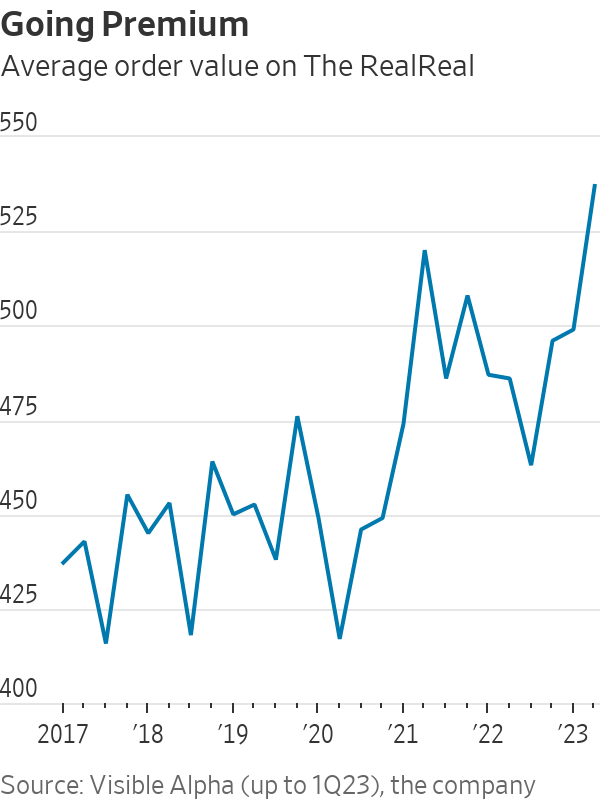Secondhand Sellers Are Going Premium
The RealReal and ThredUp have gone upscale to improve profitability—a challenge in tougher economic times
In theory, a weakening economic environment seems good for secondhand platforms: People are more likely to sell valuable items from their closets while bargain hunters emerge. In practice, it is a bit more complicated.
The RealReal, an online marketplace for luxury resale, said on Tuesday that gross merchandise value—the total value of goods sold through its platform—fell 7% in its second quarter, worse than the 5.7% decline that Wall Street analysts were penciling in. ThredUp, which sells more generic brands, fared better and reported revenue growth of 8%, exceeding expectations. Both companies reported narrower net losses than analyst expectations, sending The RealReal up 6% in after-hours trading and ThredUp by 2.8%.
Despite better-than-expected profits, the selling environment isn’t exactly hospitable for either platform.
ThredUp, which tries to keep its pricing 60% to 70% lower than what consumers could buy at regular retail, is facing a very promotional environment in which brands are offering steep discounts on new products. On the company’s earnings call on Tuesday, ThredUp said the market for selling clothes remains competitive, though it is improving.

Meanwhile, demand for luxury goods has generally been lukewarm in the U.S. Even the prices of highly coveted secondhand watches such as Rolexes have fizzled recently. ThredUp is projecting a slowdown in top-line growth this year compared with 2022, while The RealReal is expecting a slight decline in sales volume.
Both platforms are trying to attract wealthier, more resilient customers by upgrading their product mixes, even if it reduces their customer base in the near term. ThredUp said the budget shopper continues to look more challenged and said it is focused on attracting the “incrementally more premium buyer.”
The RealReal, meanwhile, has tweaked its commission structure for consignors by allowing them to retain more of the revenue earned from the sale of the most expensive, in-demand items while reducing incentives on products selling for less than $100. While that has reduced the company’s sales volume, it helped improve gross margins to 65.9% last quarter, up about 9 percentage points from a year earlier.
The tricky part for both platforms is that they haven’t been around long enough to know how their target buyers and sellers behave during downturns. Given that both businesses are, to some extent, supply constrained, further weakness could be a good thing if it encourages more people to raid their wardrobes. And, judging by the strong record at off-price retail during downturns, demand for value products should hold up.
So far, though, a weakening economic environment hasn’t been a bonanza for secondhand goods.
 Copyright 2020, Dow Jones & Company, Inc. All Rights Reserved Worldwide. LEARN MORE
Copyright 2020, Dow Jones & Company, Inc. All Rights Reserved Worldwide. LEARN MORE
This stylish family home combines a classic palette and finishes with a flexible floorplan
Just 55 minutes from Sydney, make this your creative getaway located in the majestic Hawkesbury region.
Continued stagflation and cost of living pressures are causing couples to think twice about starting a family, new data has revealed, with long term impacts expected
Australia is in the midst of a ‘baby recession’ with preliminary estimates showing the number of births in 2023 fell by more than four percent to the lowest level since 2006, according to KPMG. The consultancy firm says this reflects the impact of cost-of-living pressures on the feasibility of younger Australians starting a family.
KPMG estimates that 289,100 babies were born in 2023. This compares to 300,684 babies in 2022 and 309,996 in 2021, according to the Australian Bureau of Statistics (ABS). KPMG urban economist Terry Rawnsley said weak economic growth often leads to a reduced number of births. In 2023, ABS data shows gross domestic product (GDP) fell to 1.5 percent. Despite the population growing by 2.5 percent in 2023, GDP on a per capita basis went into negative territory, down one percent over the 12 months.
“Birth rates provide insight into long-term population growth as well as the current confidence of Australian families,” said Mr Rawnsley. “We haven’t seen such a sharp drop in births in Australia since the period of economic stagflation in the 1970s, which coincided with the initial widespread adoption of the contraceptive pill.”
Mr Rawnsley said many Australian couples delayed starting a family while the pandemic played out in 2020. The number of births fell from 305,832 in 2019 to 294,369 in 2020. Then in 2021, strong employment and vast amounts of stimulus money, along with high household savings due to lockdowns, gave couples better financial means to have a baby. This led to a rebound in births.
However, the re-opening of the global economy in 2022 led to soaring inflation. By the start of 2023, the Australian consumer price index (CPI) had risen to its highest level since 1990 at 7.8 percent per annum. By that stage, the Reserve Bank had already commenced an aggressive rate-hiking strategy to fight inflation and had raised the cash rate every month between May and December 2022.
Five more rate hikes during 2023 put further pressure on couples with mortgages and put the brakes on family formation. “This combination of the pandemic and rapid economic changes explains the spike and subsequent sharp decline in birth rates we have observed over the past four years,” Mr Rawnsley said.
The impact of high costs of living on couples’ decision to have a baby is highlighted in births data for the capital cities. KPMG estimates there were 60,860 births in Sydney in 2023, down 8.6 percent from 2019. There were 56,270 births in Melbourne, down 7.3 percent. In Perth, there were 25,020 births, down 6 percent, while in Brisbane there were 30,250 births, down 4.3 percent. Canberra was the only capital city where there was no fall in the number of births in 2023 compared to 2019.
“CPI growth in Canberra has been slightly subdued compared to that in other major cities, and the economic outlook has remained strong,” Mr Rawnsley said. “This means families have not been hurting as much as those in other capital cities, and in turn, we’ve seen a stabilisation of births in the ACT.”
This stylish family home combines a classic palette and finishes with a flexible floorplan
Just 55 minutes from Sydney, make this your creative getaway located in the majestic Hawkesbury region.





















